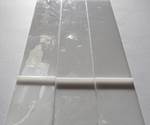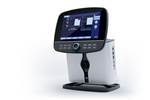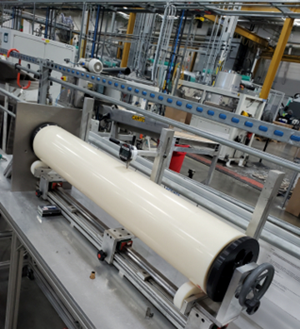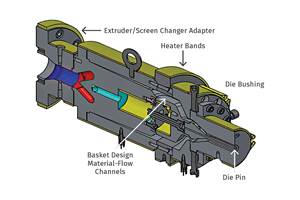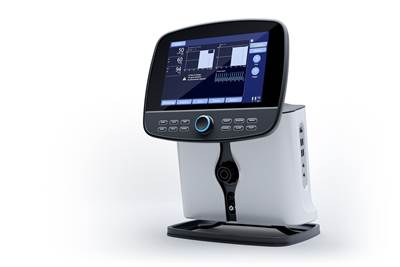Conair, Partners Run TPE Tubing, ABS 3D Filament at Medical Show
Conair joins Davis-Standard and Zumbach to demo complete system that switched between tubing and filament runs at Plastec West Show in California.
At the Plastec West Show, February 11-13 in Anaheim, Conair Group teamed with Davis-Standard and Zumbach Electronics to process a 4.5-mm (0.18-in.) TPE medical tubing and ABS 1.7mm 3-D-printing filament, switching back and forth throughout the show.
The demonstration marked the first MD&M appearance of Conair’s space-saving HTMP multi-pass vacuum-sizing/cooling tank and the ATC Series coiler. With the HTMP, instead of making a single pass through a long tank, the extrudate follows a Z-shaped path so that the compact, 12-ft-long HTMP tank provides cooling time equivalent to a 30-ft tank. The ATC Series coiler provides tensionless winding of extruded tubing and filament to prevent damage, and is equipped with an automatic coil-isolation safety feature that prevents user access to moving coils.
IV Tube Run
A 2-in. Super Blue Davis Standard extruder, equipped with a Touch Panel Control, was supported by Conair upstream and downstream equipment, with downstream measurement and monitoring provided by Zumbach Electronics. The TPC integrates all these downstream inputs for complete line control through a single HMI. The demonstration line can deliver production rates up to 400 ft/min.
On the medical tubing runs, TPE was fed to the extruder feedthroat through a self-contained Conair Access Series AL-2 mini-loader. After processing through the extruder, tubing leaves the die and immediately enters the Conair HTMP multi-pass tank. The tank is the first of four MedLine auxiliaries on display by Conair: all are medical-grade variants of proven Conair auxiliary equipment designs that are specially sized, configured, documented, and supported for cleanroom applications.
“Floor space in any manufacturing plant is costly, and even more so in a cleanroom environment.” says Ernie Preiato, Conair’s v.p. extrusion sales. “Considering our multi-pass tanks occupy only about a third of the space a full-length, single-pass tank requires, the savings and convenience are considerable.”
The HTMP tank uses a series of motorized sheaves to gently pull extrudate through cooling water, starting with a 6-ft vacuum chamber that creates a positive differential in air pressure within the extruded tube. This slight outward pressure helps stabilize tube dimensions before additional cooling passes while preventing any “drool” of cooling water out of the tank’s feed opening that could mar the surface finish of the product.
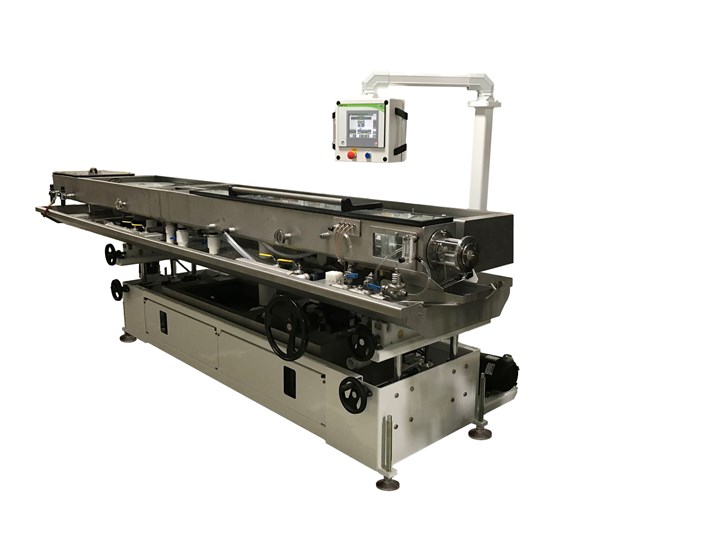 The MedLine HTMP combination vacuum/cooling tank combines the functions of a puller (using motorized sheaves), a vacuum tank, a cooling tank, and an air-wiping device.
The MedLine HTMP combination vacuum/cooling tank combines the functions of a puller (using motorized sheaves), a vacuum tank, a cooling tank, and an air-wiping device.
At the same time, a pair of Zumbach Electronics ultrasonic gauges—one each near the tank entrance and exit—continuously monitor and report changes in tube wall thickness on a control screen as the tubing cools. Further downstream from the tank, a Zumbach 3-axis O.D. laser gauge provides not only closed-loop dimensional control, but also displays the tube profile for concentricity adjustments. Together, data from the ultrasonic and laser gauges are used to regulate puller speed and cooling-tank vacuum to maintain critical tube dimensions over the production run.
Because precise temperature control is also essential to proper extrudate drawdown and sizing, the HTMP vacuum cooling tank is served by a MedLine Thermolator TCU and a Conair EP1A-02 (two-ton) portable air-cooled chiller.
The finished extrudate (tube or filament) then moved through a Conair MedLine Pinch Roll puller. The programmable, dual-servo precision puller is commonly used on high-speed medical tube lines that feed their output onto coilers. In this case, the coiler is a Conair MedLine ATC Series coiler. Its floor-mounted ultrasonic loop sensor monitors the incoming product, automatically adjusting coil speed and traverse motion to wind product smoothly into a military wrap, without the friction or tension that can distort delicate extruded products.
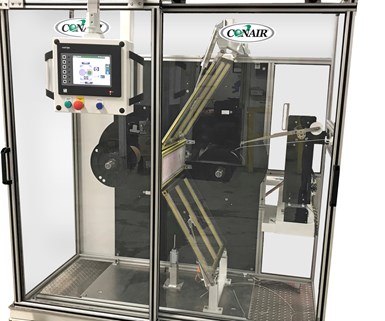
Conair latest ATC Coiler features a new coil-isolation safety feature that locks out user access during automatic coil changes.
As one coil is filled, the dual-spindle ATC Series automatically adjusts, rotating the full coil out of the way, cutting the extrudate, then rapidly transferring it to the empty spindle to continue winding. The unit’s automatic coil-isolation feature locks out access during coil transition, then actuates upper and lower safety gates that isolate the actively winding spindle, enabling users to safely access and remove full coils on the other side of the cabinet.
Like the other Conair MedLine auxiliaries, the coiler is also outfitted in RAL 9000 medical paint on non-contact surfaces, with stainless steel on any product-contact surfaces. It is equipped with a full guarding package that includes an aluminum frame and clear viewing doors that interlock for safety.
3D Filament Run
On the production of ABS 1.7-mm 3-D filament, the demonstration highlighted the dramatic growth of 3-D printing as a manufacturing process, answering the questions of many manufacturers who are evaluating the development of their own filament extrusion lines as a way to increase control over filament quality, minimize pre-conditioning requirements, and control costs.
Changing the extrusion line to filament production is straightforward: the only hardware changes involve installing a filament extrusion die and a “pre-skinner,” a non-contact sizing chamber, at the entrance of the HTMP multi-pass vacuum sizing tank. The pre-skinner, engineered at Conair’s Extrusion Laboratory in Pinconning, Mich, is a water-filled chamber used to pre-cool and “skin” the surface of the filament extrusion before it comes into contact with calibration sleeves in the vacuum cooling tank. Without the benefit of pre-skinning, the hot filament could repeatedly stick and release on the calibration sleeves, resulting in “chatter” marks that mar the dimensional consistency and surface finish of the extruded product.
Related Content
High-Speed Cutters for Corrugated Tubing
Applications for new cutter line include medical, automotive, and other industrial.
Read MoreTeel Straps on Yellow Belt to Cut Scrap on Big Cores
Investments in a lean, continuous process pay off for this Wisconsin processor.
Read MoreHow to Select the Right Tooling for Pipe Extrusion
In pipe extrusion, selecting or building a complementary set of tooling often poses challenges due to a range of qualitative factors. Here’s some guidance to help you out.
Read MoreOnline X-Ray Inspection Boosts Extrusion Quality
Höhle uses Sikora’s x-ray measuring systems for inline quality control of extruded microducts.
Read MoreRead Next
Materials: Low COF Acetal for Smooth Medical Device Actuation
DuPont’s Delrin SC696 provides smoother surfaces and good colorability.
Read MoreMaterials: Flame-Resistant Specialty Copolyesters for Electronic Medical Devices
Eastman’s newly expanded portfolio of Tritan MXF copolyesters includes flame-retardant grades for housing and hardware of electronic devices.
Read MoreMaterials: PC Resins for Drug Delivery and Surgical Devices
Covestro launches two new medical-grade families of polycarbonate.
Read More

